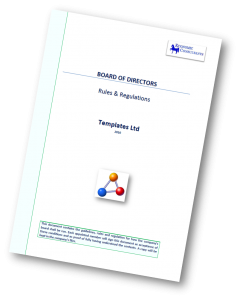A board of directors is a body of elected or appointed members who jointly oversee the activities of a company or organization. Other names include board of governors, board of managers, board of regents, board of trustees, and board of visitors. It is often simply referred to as “the board”.
In some European Union and Asian countries, there are two separate boards, an executive board, also called corporate executive team, for day-to-day business and a supervisory board, also called board of directors (elected by the shareholders) for supervising the executive board.
A board’s activities are determined by the powers, duties, and responsibilities delegated to it or conferred on it by an authority outside itself. These matters are typically detailed in the organization’s bylaws. The bylaws commonly also specify the number of members of the board, how they are to be chosen, and when they are to meet.
In an organization with voting members, e.g., a professional society, the board acts on behalf of, and is subordinate to, the organization’s full assembly, which usually chooses the members of the board. In a stock corporation, the board is elected by the stockholders and is the highest authority in the management of the corporation. In a non-stock corporation with no general voting membership, e.g., a university, the board is the supreme governing body of the institution; its members are sometimes chosen by the board itself.
Typical duties of boards of directors include:
- governing the organization by establishing broad policies and objectives;
- selecting, appointing, supporting and reviewing the performance of the chief executive;
- ensuring the availability of adequate financial resources;
- approving annual budgets;
- accounting to the stakeholders for the organization’s performance.
- setting their own salaries and compensation
The legal responsibilities of boards and board members vary with the nature of the organization, and with the jurisdiction within which it operates. For public corporations, these responsibilities are typically much more rigorous and complex than for those of other types.
Typically the board chooses one of its members to be the chairman, who holds whatever title is specified in the bylaws.
—————
Below we have shown a simple but useful document which regulates the conditions and goal for each memeber of the Board of Directors.
Rules & Regulations
This document contains the guidelines, rules and regulation for how the company’s board shall be run. Each appointed member will sign this document as acceptance of these conditions and as proof of fully having understood the contents. A copy will be kept in the company’s files,
Guidelines, Rules & Regulations to Appointed
Members of the ABC Board of Directors
Members Name
Company Goal
Minimum annual return on investment of x0%
Involvement period
3 to 5 years to realise the value
Contribution
Business development focusing on internationalisation, sales and fund raising
Each Member of the Board formally represents all shareholders and must by guidance and control, ensure that the company’s assets are managed in the best way for the owners.
The companies’ act defines specific demands to the size of equity and proper management and the responsibility of the Board of Directors in that connection.
ROLES AND TASKS
Goals
The Board’s responsibility is to make sure that the company is working towards defined short and long-term goals. These goals must be in accordance with the company’s business idea, vision and strategy. There should be few goals, which all are directed towards critical success factors.
Strategy
The Board must ensure that the company formulates a clear strategy. A focused and long-term strategy, which is understood by all involved, is important to make sure that all resources are allocated and pull in the same direction.
Control
The Board should obtain regular profit/loss reports and ensure compliance with short and long-term goals.
A monthly-composed year-end prognosis is a useful additional tool. The Board must also make sure that the results presented show the actual situation.
Cash Flow
Both in start up situations and in growth periods companies normally require additional funding. Having a running cash flow control and long term cash flow planning is a major responsibility to the Board.
Strengthening the cash position is best undertaken at the early stages before liquidity problems develop in response to forward requirement projections.
Variance
The Board must ensure that any variance from the business plan or ISO quality assurance methodology is addressed by the management. The board should treat and approve actions related to significant deviations.
Individuality
Every Company develops its own distinctive character and it is important that the Board respects and further develops this.
Members of the Board shall of course build on own experience, but not uncritically copy from other engagements.
Managing Dirctor / CEO
The Board is formally the MD’s superior. One of its most important tasks is to recruit, develop, support and if necessary replace the MD.
Roles
Ownership, board responsibilities and leadership are different roles in a company. In small and medium size companies, the roles often are mixed, some times with unfortunate consequences.
Determination
The board must be wiling to take actions as and when required to ensure the success of the company and at the same time ensure the management agrees with and supports the decisions board.
Risk Factors
Within the field of managing funds on behalf of the shareholders lay an ongoing evaluation of risks and supporting actions.
Risks are defined as:
Unwanted and unforeseen things can happen
Inefficient operation and processes
Failure to exploit the possibilities, market, product, and technology
The Board must initiate remedial actions where and when required.
Composition
It is the General Assembly who elects the Board of Directors. However the Board should make an evaluation on how the Board should be best composed. No conflicts of interest that lead to side considerations by the individual board member should exist
The Board should have a composition of competence that matches the company’s situation and needs and complements the company’s own competence levels.
The climate in the Board should be of such a nature that it allows creative dissensions without undermining the Board as a collegium.
Board Meetings
It is important that a part of the agenda is standard and another part is of current interest or more comprehensive matters as budgets, total strategy, development of the organization, market strategies, financial management etc.
On a regular basis, the board should discuss its own way of working and allow the Chairman to initiate required change. Matters to the Board should consist of resolutions, discussions and information.
Accessibility
The Board shall on behalf of the Shareholders actively support the business and the management. Board members should be able to allocate sufficient time to the company and have time to prepare and follow up Board Meetings.
Meetings
It is important to keep frequent meetings, if possible from 6 to 12 per year. All depending on where the company is at any given time in the cycles.
Fees
Chairman, risk £ X.000 per year
Board member, risk £ Y.000 per year
Meetings £ Z.000 per meeting
———————–
London, December 31st 2010
Templates Ltd
Name Name
Chairman Member of the Board




